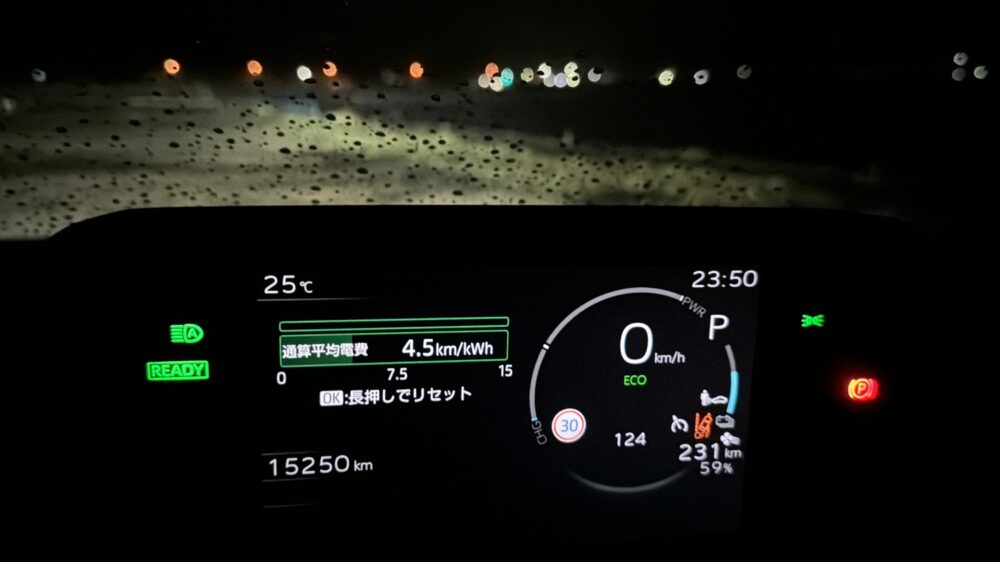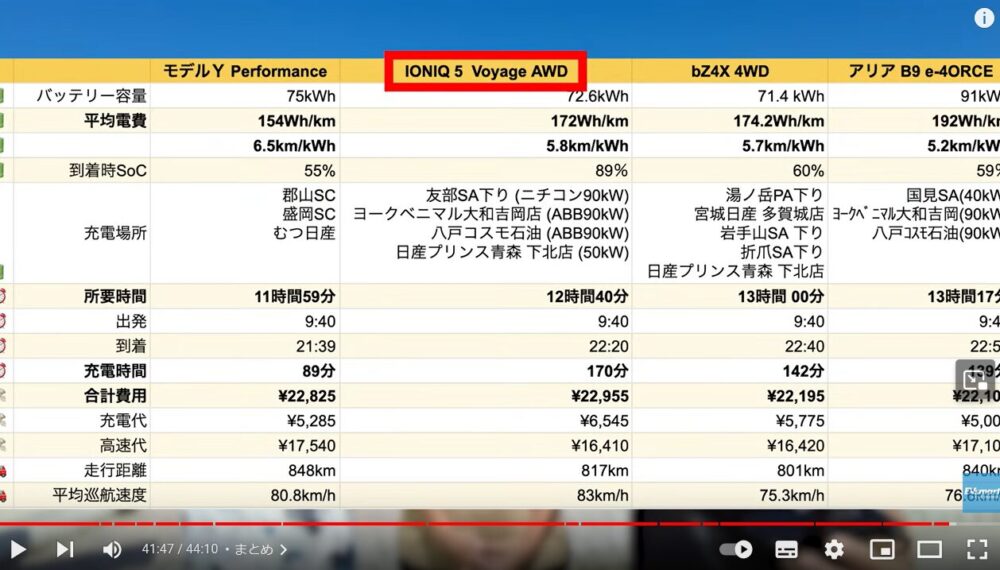Once I rented a bz4x , I wanted to try it out to see how the cruising range decreased when cruising at ultra-high speeds, the level at which Orvis shines at over 120km/h .
I crashed through heavy rain late at night on the Chita Peninsula Road, which is a mountain road with many ups and downs like the Chuo Expressway.
I can’t say exactly how many km/h I was driving, but the Orvis was running smoothly and continued to run even above the cruise control’s maximum speed setting. It was an incredibly fast ride.
Electricity cost is 4.5km/kWh (222Wh/km)
I started the station at 80%, but it dropped to 59% after driving about 50km.
Considering this, it takes 20% to run 50km. At 100%, it has a cruising range of 250km.

The resulting electricity cost 4.5km/kWh (222Wh/km) . was
The actual high-speed electricity costs are expected to be even worse, as the section includes sections where the train was driven slowly through the city late at night.
The battery capacity is 71.4kWh.
You can run 1km with 0.222kWh, so 71.4kWh 321km . is equivalent to
The reason the cruising range differs from the previous calculation is because the design leaves electricity inside the battery below the indicated 0%.
Comparison with Toyota’s official value: 43% reduction from WLTC mode

The cruising range of the G grade 4WD in WLTC mode is 567 km, which is 43.3% less than the official value .
Since the air conditioning is set to a conservative setting, it is expected that the situation will worsen in the middle of winter when heating consumption increases.
Comparison with experimental results of other EV YouTubers
In the video of Mr. EV Native Data from actual driving tests of bz4x is recorded.
Please take a look at the table below, keeping in mind that my electricity bill was 4.5km/kWh.

The closest one would be the AWD grade HighSpeedTest in the middle of the table.
As a result of driving at an average vehicle speed of 115 km/h, the electricity consumption was recorded at 4.0 km/kWh.
The electricity consumption reduction rate of bz4x during high-speed cruising is approximately 25%
EVSmart’s verification video includes electricity costs when running long distances at a typical pace.
According to this, it is written as 5.7km/kWh.
The average speed when traveling 800 km in 13 hours is approximately 61 km/h, so the average cruising speed of 75.3 km/h excludes charging and rest time.

Considering the 4.0kmkWh, the electricity cost reduction rate during high-speed cruising is 29.8%.
Considering 4.5kmkWh, the electricity cost reduction rate during high-speed cruising is 21.05%.
The average of these two numbers is 25.425.
To summarize for now, increasing the cruising speed from about 75km/h to about 110km/h will reduce electricity costs by 25% . it can be said that
bz4x ‘s electric cost reduction rate in midwinter is 15.78%
The average vehicle speeds on the far left and in the middle of the table above are almost the same.

The difference in temperature is -3~-1℃ and 15~17℃.
However, electricity costs have decreased from 4.5km/kWh to 3.79km/kWh.
This reduction rate is 15.78%.
Is the electricity cost reduction rate 40.78% when driving on the expressway in the middle of winter?
Adding the above two electricity cost reduction rates gives 40.78.
If you fly on a highway at speeds of 120km/h in the middle of winter, you can expect your cruising range to be reduced by about 40%.
In the middle of winter, it will be important to reduce heating and cruising speed.
It is also said that similar energy consumption occurs due to air conditioning even on midsummer days under the scorching sun, when the temperature exceeds 40 degrees Celsius and the sun’s rays shine down.



